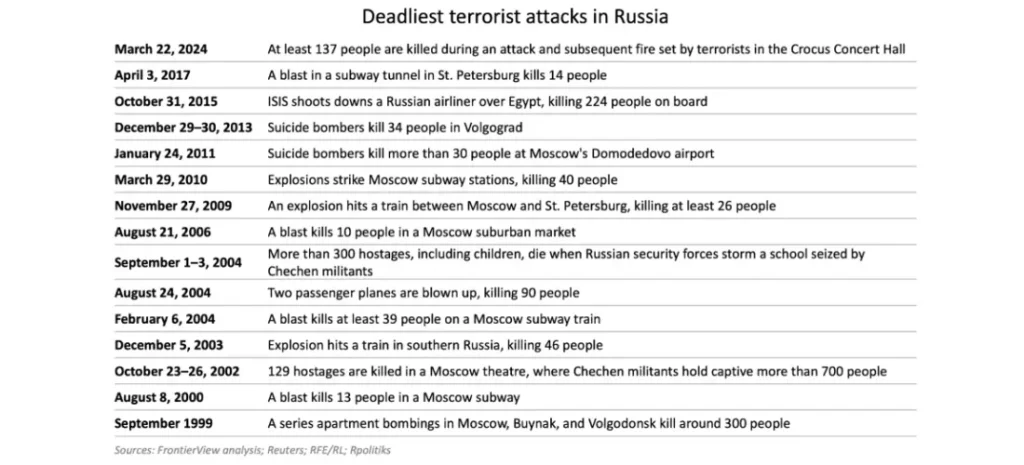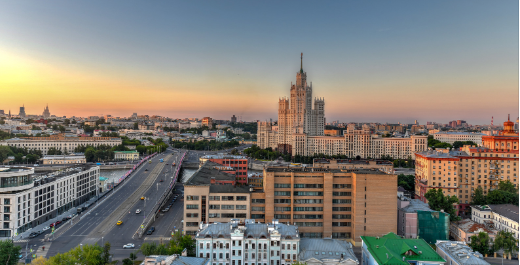
Kremlin will seek to associate the terrorist attack with Ukraine to increase public anger against Ukrainians, but a U-turn in policy and tactics toward the war is unlikely
Immediate implications for individuals and businesses in Russia are represented by the heightened terrorism threat and the likely tightening of internal security. With Russian security services currently occupied with the war in Ukraine and suppressing anti-war sentiments, there remains a window of opportunity for terrorists to exploit due to the country’s divided attention.
As Russian security services conduct anti-terror operations, pressure and reprisals against labor migrants from Central Asia and the South Caucasus will increase. Some Central Asian countries have advised their citizens against traveling to or staying in Russia due to rising anti-immigrant sentiment. Businesses that currently employ labor migrants or employees with previous citizenship from Central Asia or the South Caucasus may face heightened scrutiny and increased questioning regarding their workforce. However, a stricter migration policy that would limit labor migrants is less likely given acute staff shortages in the already-tight labor market.
An ongoing terrorism threat is likely to deter people from attending large gatherings, including shopping malls, which could have a temporary negative impact on retail sales in large cities, especially for non-food products.
Overview
- At least 139 people were killed in a terrorist attack at Crocus City Hall in the Krasnogorsk, Moscow region on March 22. Eleven individuals, including four gunmen, were detained in the Bryansk Region while allegedly attempting to cross the border.
- This marks the largest terrorist attack in Russia in the past two decades. The most recent deadliest attack occurred in 2004 when Chechen militants seized hostages in a school, resulting in the deaths of over 300 people, including many children.
- ISIS claimed responsibility for the attack later in the day through the news outlet Amaq on Telegram. ISIS-Khorasan, which is believed to be behind the attack, is mostly based in Afghanistan but has a large number of followers in Central Asia, Russia, and even European countries.
- The last ISIS attack against Russia occurred outside the Russian Embassy in Kabul in September 2022, where a suicide bomber detonated explosives, killing two embassy staff and others. Given that Russia was among the few countries to keep its embassy open in Afghanistan at that time, it remained uncertain whether the attack specifically targeted Russia or any European country.
- Several weeks before the attack, the US embassy warned its citizens in Russia about potential terrorist attacks at large gatherings in Moscow, including concerts. US intelligence also reportedly alerted their Russian counterparts about potential ISIS attacks. Before the attack, President Vladimir Putin dismissed these warnings as blackmail aimed at intimidating and destabilizing society, although it is highly likely that the Federal Security Services (FSB) took some precautionary measures. For example, on March 7, the FSB claimed to have prevented an ISIS-plotted attack on a synagogue in Moscow.
- Following the attack on March 22, the Russian side accused the US of providing insufficient details in its warnings, attempting to mask the security services’ incompetence. However, it looks that the tactics employed in the recent terrorist attack are designed to make it difficult to uncover.
- The attack was carried out not by suicide bombers with clear ISIS connections, but by financially incentivized terrorists without a documented history of collaboration with ISIS, at least according to preliminary information provided so far.
- The preparation for such a large-scale operation reportedly took only about a month, as claimed by one of the gunmen, which helped avoid potential information leaks and making it difficult to reveal in advance. Some also question the tactics used in the operation, as they diverge from ISIS’s typical use of suicide bombers. However, there have been previous instances of ISIS-linked attacks not involving suicide bombers.
Our View
We expect the Kremlin will use this as a chance to blame Ukraine and promote its anti-West and anti-Ukraine narratives, painting Ukraine and the West as common enemies to Russians, tarnishing Ukraine’s global image, and justifying its invasion. However, we don’t foresee any immediate changes to its war plans because of the attack.
Putin acknowledged the involvement of radical Islamists in the terrorist attack but did not rule out the possibility of Ukraine and the US being involved behind the scenes. While not directly accusing them due to lack of clear evidence, this approach leaves room for pro-Kremlin personalities and government supporters to speculate further and point the finger at Ukraine. Russia is likely to search for signs linking Ukraine to the attack, as it aligns with the Kremlin’s interests. The Russian foreign ministry has already expressed suspicions about the US blaming ISIS and dismissing Ukraine’s involvement immediately after the attack, indicating that the escalation in rhetoric likely represents an attempt to fuel further domestic support for Moscow’s foreign ventures, and Kremlin propaganda has been actively promoting the idea of Ukraine’s involvement in its narrative since the attack occurred. Soon after the attack, the FSB and pro-Kremlin media began circulating information about a supposed “special window” at the border with Ukraine, intended to assist terrorists in escape. However, these reports did not specify how the four gunmen were supposed to travel through the heavily controlled and mined border with Ukraine.
ISIS has long viewed Russia as an adversary due to its involvement in operations in Syria, where it aids groups opposed to ISIS. Additionally, Russia’s growing ties with the Taliban, which ISIS views as weak adversaries, and its attitude toward Muslims from the North Caucasus and Central Asia, particularly when it comes to labor migrants, who are also easy targets for ISIS recruitment, have fueled ISIS’s hostility toward Russia over these years.
Any large-scale mobilization, which many had expected after the terrorist attack, does not appear to be an imminent risk. Just days before the attack, Defense Minister Sergey Shoygu announced Russia’s plans to establish two new armies and 30 new formations with 14 divisions and 16 brigades by the end of 2024 and increase the size of armed forces from 1.15 million to 1.5 million personnel. In our view, this plan seems overly ambitious and less likely to materialize, considering the current slow pace of contractor recruitment. However, given the negative implications on the economy and political costs involved, Putin will also delay any potential large-scale mobilization as much as possible, relying comfortably on highly paid contractors. In addition, Russia’s manpower advantage over Ukraine on the battlefield, coupled with Ukraine’s struggles to mobilize additional soldiers due to political costs and delays in receiving military support from the US, also favors Putin’s current strategy.
At FrontierView, our mission is to help our clients grow and win in their most important markets. We are excited to share that FiscalNote, a leading technology provider of global policy and market intelligence has acquired FrontierView. We will continue to cover issues and topics driving growth in your business, while fully leveraging FiscalNote’s portfolio within the global risk, ESG, and geopolitical advisory product suite.
Subscribe to our weekly newsletter The Lens published by our Global Economics and Scenarios team which highlights high-impact developments and trends for business professionals. For full access to our offerings, start your free trial today and download our complimentary mobile app, available on iOS and Android.

